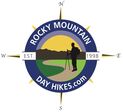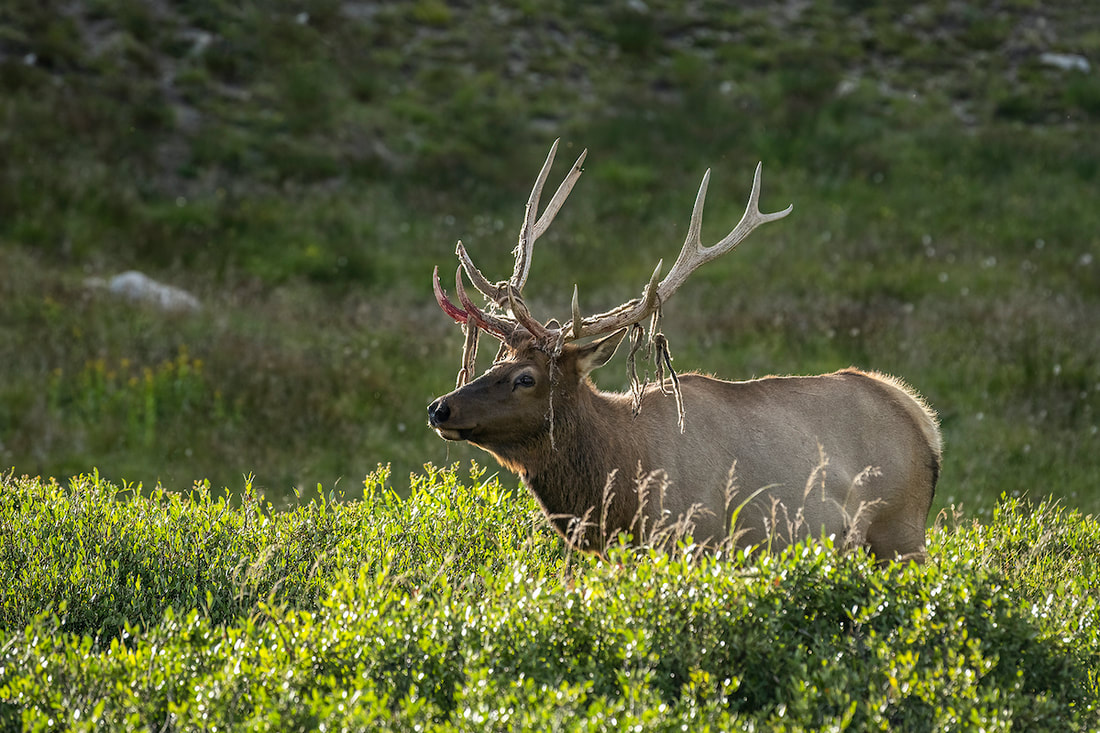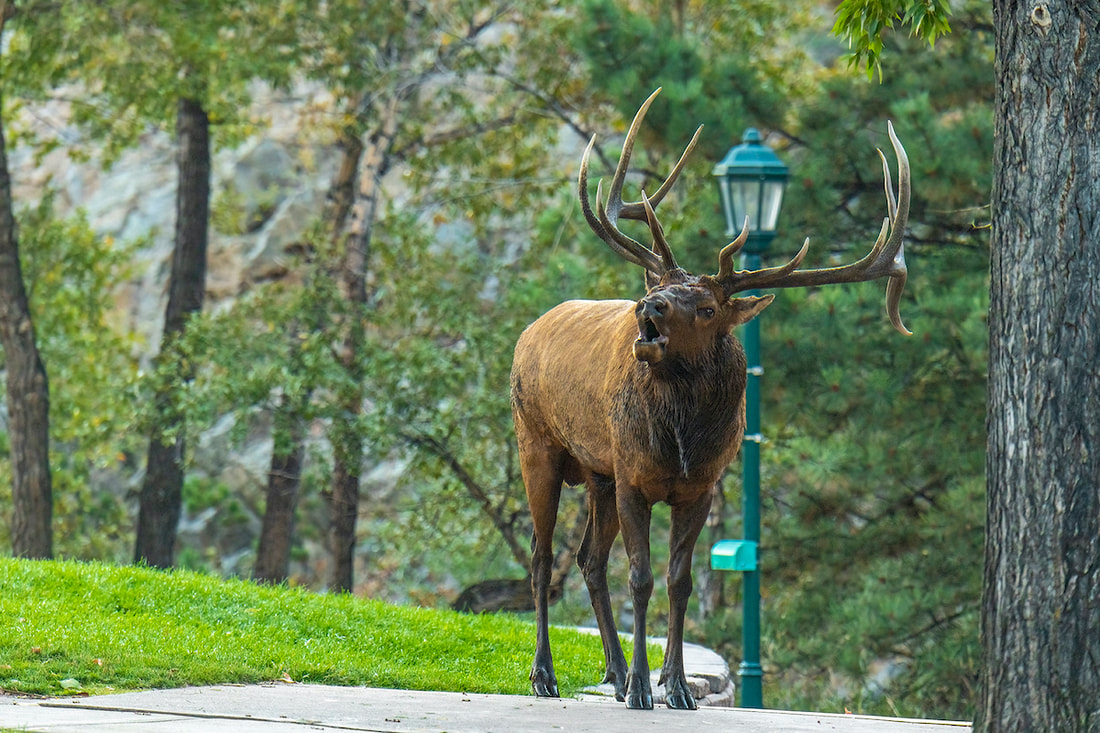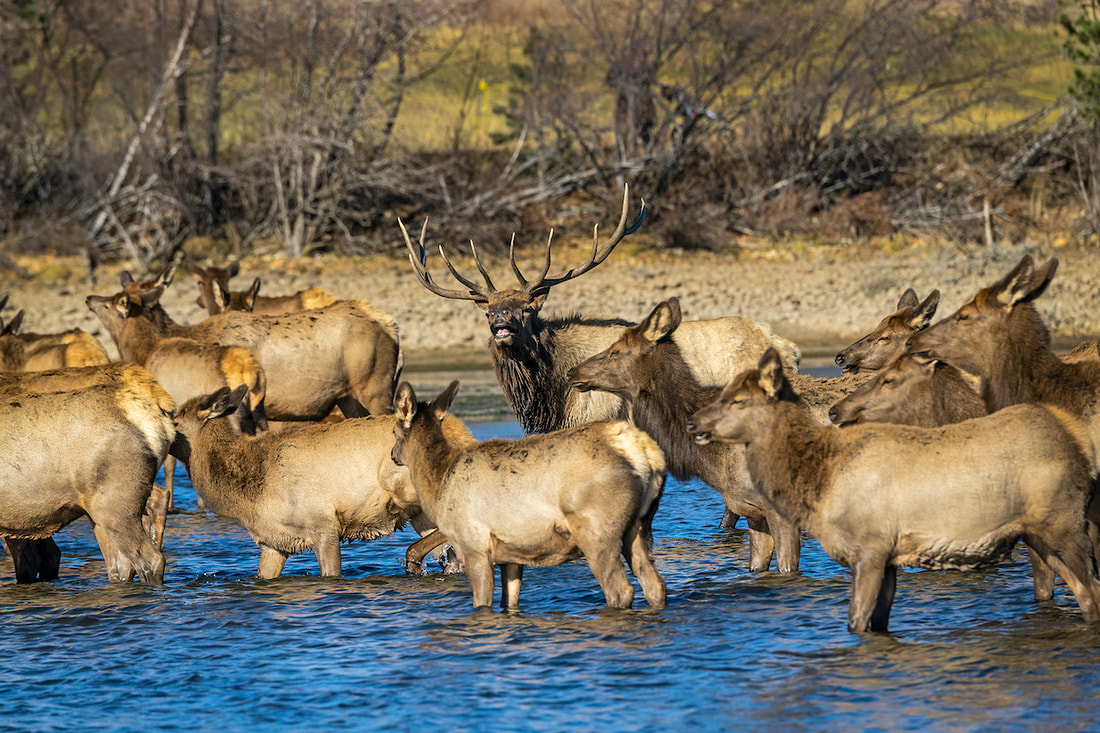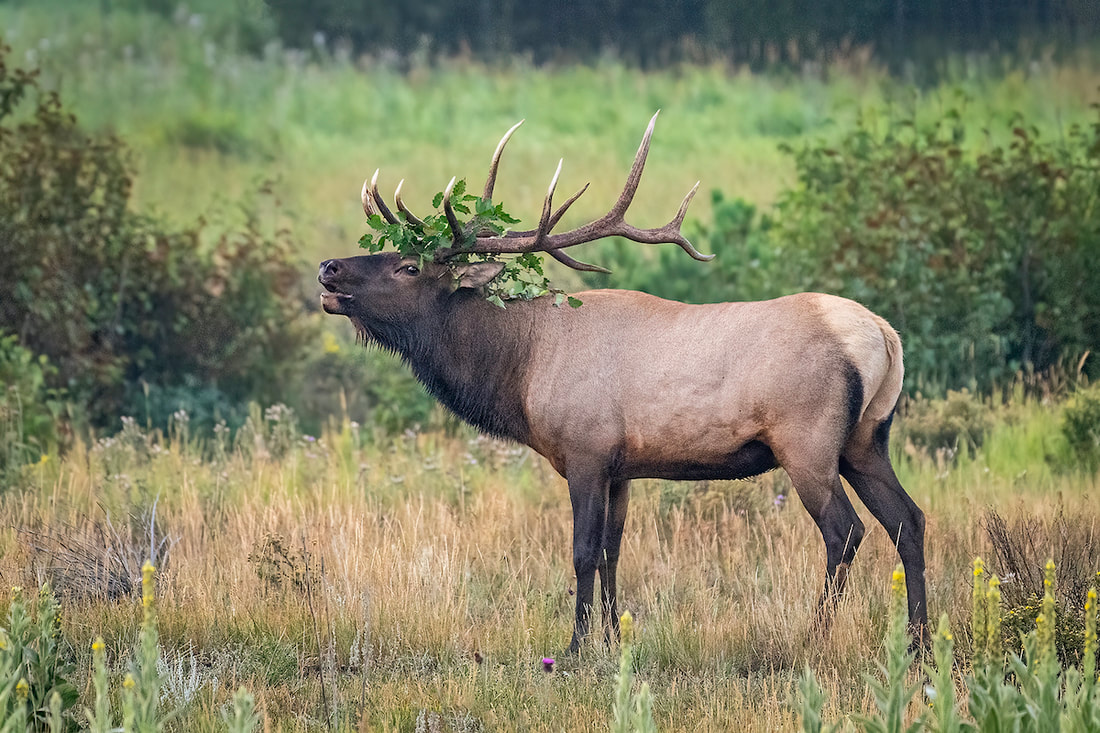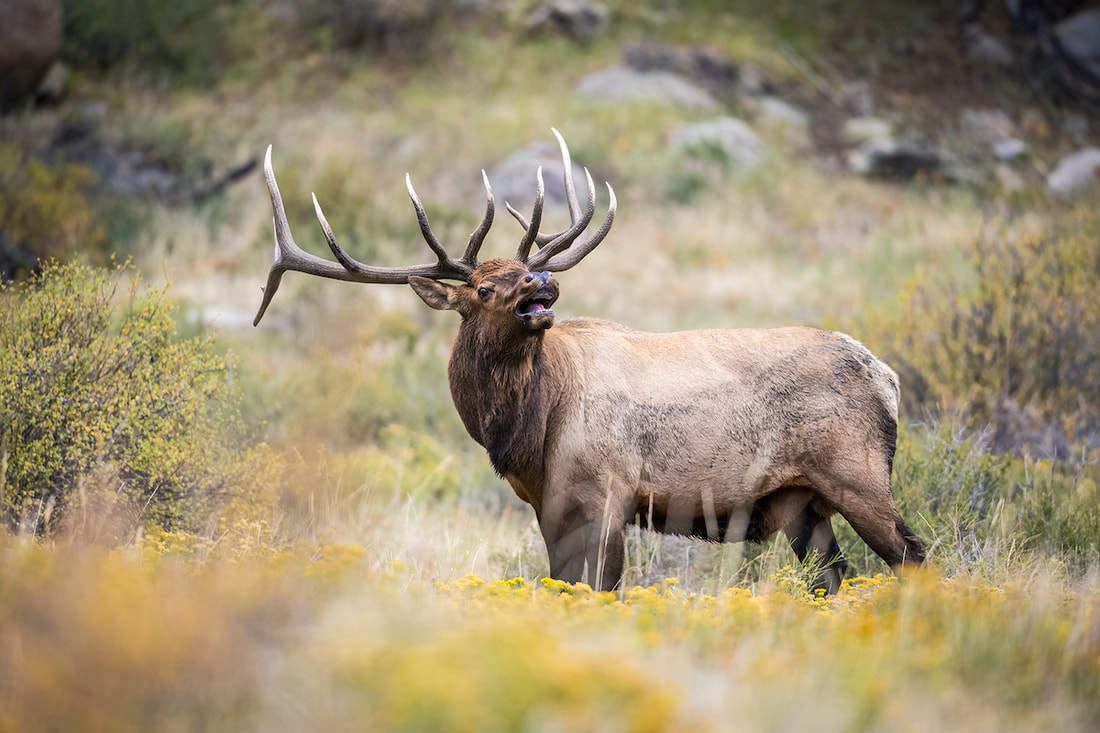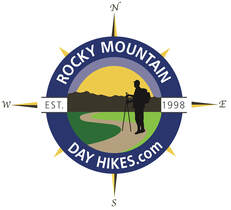|
Notes from the
Trail |
|
By Dawn Wilson, Dawn Wilson Photography Did you know that headdresses have come back in fashion? Headdress you say? What the heck is a headdress? Is that like a ring of flowers or a bonnet of feathers? Well, kind of. Headdresses catch the lady’s eye – but only cow elk truly find these “top hats” made of branches, twigs, grasses, leaves and anything else a bull elk can snag into his antlers something to take notice of in the fall. We have entered the mating season – or rut – for the Rocky Mountain elk and the headdress plays a part in the annual courtship process of the elk. Timing of the elk rut This magical season starts each year about the second week of August when the bull elk shed the velvet from their antlers. Although the elk have not quite entered the rut season, this transformation is the first sign of the impending cacophony of bugles, glunks, barks and chuckles that will fill the mountain valleys in a few weeks. As testosterone in bulls increases, it sends a signal to the vascularized velvet to stop providing nutrients to the growing antlers. As the blood flow stops in this outer layer of fuzzy skin over the antlers, the velvet dries up and peels away. It is believed to be itchy to the animal, causing him to scrape and rub it off his rack. The process only takes about 24 hours once started, leaving behind the underlying bone stained red from the blood in the fallen velvet for a few days. His antlers now need to be prepped for battle. For the Rocky Mountain elk, their antlers are the largest of the six subspecies of elk, weighing up to 40 pounds on the largest and healthiest bulls. These projections extending from a pedicle on his head will be used to show his size, maturity, health and fighting ability during the tournament to breed. The bull will sharpen up the points and smooth out the sides by rubbing the antlers on trees, branches, shrubs and even the ground. As August blends into September, the rut season begins to come into full swing. Although warm, sunny days can keep the elk herds hidden in the shade during the heat of the day, a cool, cloudy day is sure to offer a longer opportunity to observe the massive animals. The rut season in Colorado peaks from about the third week of September to the first week of October. As cows become impregnated and testosterone levels begin to decline in bulls, the activity begins to wind down by the middle of October. By early November, many of the bulls are gathering back into bachelor herds and resting out of sight to recuperate from the taxing activities of the season. By late fall, the piercing bugle becomes a distant memory as the meadows become quiet again and the snow begins to blanket the dried grasses of summer. Many of the larger bulls have been actively pursuing cows, fighting other suitors and chasing away interlopers since late August. The bulls, which can weigh as much as 700 pounds, may lose up to 20% of their body weight during this time. Some bulls often tap out of the activity early, either due to injury or exhaustion, giving younger bulls a chance to spread their genes. Catching a glimpse of the action The best times of day to watch the mating activity is in the early morning and late afternoon when the air is still cool and the dampness may hang heavy in the meadows. Morning in particular can offer the best chance to experience foggy meadows, dew covered vegetation or fresh snow across the scene, all ideal for unique photographs. In Rocky Mountain National Park, the best places to observe the rut activity are open meadows, such as Horseshoe Park, Upper Beaver Meadows and Moraine Park, with the latter being one of the most productive locations for just the sheer volume of animals in the vicinity. Some smaller groups of elk will remain on the tundra near Trail Ridge Road until the first snowfall. A large herd of elk also live in Kawuneeche Valley on the west side of the park. Many of these elk, however, venture outside of the park into Arapaho National Forest where hunting is permitted. As a result, these elk tend to show more typical elk behavior of being active from dusk to dawn. Outside of Rocky also offers ample opportunities to watch a unique mix of rutting adult elk while the confused calves experience their first rut season. In Estes Park, it is not unusual to see elk walking downtown, strolling through Bond Park, rubbing their antlers on trees near the Visitor Center or cooling off in Lake Estes. Elk can be found just about anywhere in town during the rut season, including either of the golf courses, Stanley Park, the YMCA of the Rockies or even The Stanley Hotel property. For this reason, it is important to keep a watchful eye when in town as a startled elk coming around a corner may not let you pass. Leader of the pack Some believe that the dominant bull determines the path of the herd during the rut season. Although it may seem like he is corralling his harem – a group of elk made up of cows, yearlings and calves – it is actually the lead cow that determines when and where the unit of animals moves. The bull, however, will attempt to maintain his personal group by posturing, patrolling and bugling – both to keep the attention of the cows and to warn the competition. The dominant bull often follows behind the group as well almost like a security patrol. If a cow wanders away from the group, the bull will cut off her escape and push her back to the larger group. This whole process will continue throughout the rut season. Methods for attracting cows During the rut, the bull will also make gestures to attract females – and that’s where the headdress comes into play. One way bulls will show their dominance and mark their territory is to urinate in a shallow wallow. They may then paw at it with their hooves and thrash about the scented mud with their antlers. Sometimes the antlers will come up with that stunning headdress – the bigger the better is what he hopes will win the attention of a cow. Bulls will also urinate on their bellies, legs and feet, a kind of wapiti cologne. As the rut season progresses, visitors to the meadows in Rocky Mountain National Park may start to notice a scent reminiscent of a horse farm. This is the musky odor of the urine left by the bulls. One other behavior wildlife watchers may observe during the rut is a funny expression made by the bull elk after sniffing the urine-soaked area created by a cow.
In the urine are pheromones, the chemical smell of being in estrus. After a cow pees, a pursuing bull may sniff that area to see if she is ready to mate. To really fill those nostrils with the smell, he will lift his head and curl his upper lip into what looks like a snarl. This behavior is called the flehmen response. Doing the odd maneuver helps the pheromones reach the vomeronasal organ, a highly sensitive organ in the nasal cavity that can detect specific chemical scents. In this case, it helps the bull determine if the cow is in heat. And then everything settles back down in the meadows, the bulls return to being friends again as they gather back into their bachelor herds, and the various harems will join into one massive herd. That large herd, which can be several hundred strong, will move down into the foothills in mid-to late November. These elk will spend the winter at lower elevations. This annual ritual of fall is a sight to behold for anyone interested in the intricacies of wildlife behavior. In Rocky Mountain National Park, a timed entry reservation system is in place through much of the rut season. For the Bear Lake Corridor, which includes Moraine Park, a timed entry reservation is required from 5 a.m. to 6 p.m. through October 19. The rest of the park, which includes Horseshoe Park, Endovalley, Upper Beaver Meadows, Trail Ridge Road and Kawuneeche Valley, requires a timed entry reservation from 9 a.m. to 2 p.m. through October 13. Please remember to watch wildlife respectfully and be courteous to others also enjoying this enchanted season of valley-filling sounds, sparring bulls and courtship like no other animal in Colorado.
0 Comments
Leave a Reply. |
"The wild requires that we learn the terrain, nod to all the plants and animals and birds, ford the streams and cross the ridges, and tell a good story when we get back home." ~ Gary Snyder
Categories
All
“Hiking -I don’t like either the word or the thing. People ought to saunter in the mountains - not hike! Do you know the origin of the word ‘saunter?’ It’s a beautiful word. Away back in the Middle Ages people used to go on pilgrimages to the Holy Land, and when people in the villages through which they passed asked where they were going, they would reply, A la sainte terre,’ ‘To the Holy Land.’ And so they became known as sainte-terre-ers or saunterers. Now these mountains are our Holy Land, and we ought to saunter through them reverently, not ‘hike’ through them.” ~ John Muir |
© Copyright 2025 Barefoot Publications, All Rights Reserved
